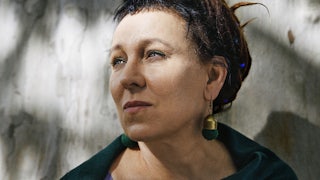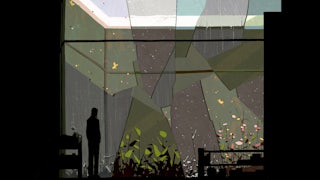“This is the girl,” a character thinks to himself on the first page of Alexandra Kleeman’s latest, Something New Under the Sun, as he watches what turns out to be a paparazzi video of a blonde actress snapping, á la Britney Spears, under the pressure of surveillance. That this phrase will make most readers think of David Lynch’s 2001 Mulholland Drive, a movie about delusion in which terrible things happen to an actress, is presumably no accident. This novel, a Hollywood satire that is also a profoundly unsettling work of sci-fi eco-horror, certainly has Lynchian moments, a familiar air of Los Angeles menace.
The zen koan–like repetition of the phrase “this is the girl” in Lynch’s film, always in reference to a young star who is fated to be famous, is designed to help us see that “the girl” is not and has never been one person, but a role filled by a series of hot babes with outsize dreams. The actress in the paparazzi video in Something New Under the Sun, Cassidy Carter, is 26 years old and, because women in the industry are seen to age in dog years, already a tired veteran. She is a former child star, an insurance liability, a diva, very jaded, and continuously underestimated, so that she is not a million miles away from several real-life figures—Lindsay Lohan, say, or Miley Cyrus, or the aforementioned Spears—who have at one time or another been chewed up and spat out by the publicity machine.
The man watching the video is Patrick, a novelist whose work is being adapted for a film that Cassidy Carter will appear in, and a non-Hollywood civilian who is out of touch enough with celebrity news that he has never seen “the girl” before. “In a face rigorously conditioned to be beautiful,” he thinks, observing Cassidy furiously upending a whole bottle of detergent on the man behind the camera, “ugly feelings come as a violation of basic principles.” Ugly feelings, as he is about to learn, are not unheard of in the movie industry, even if they are usually shown off camera. Somewhat naïve about the position he will occupy in the production, he is vastly disappointed to discover himself working as a glorified P.A., driving Cassidy to and fro at her command as the sweltering L.A. landscape routinely catches on fire all around them.
Water, in what we are led to presume is near-future California, has been replaced by a factory-engineered substance called WAT-R, conveniently provided at a cost by an enormous corporation and available in variations with banal, sinister names like “WAT-R Extra,” “WAT-R Pure,” “WAT-R Wildly Wet,” “WAT-R Misty Morning Dew,” “WAT-R Kids,” and so on. A mysterious illness, something like dementia but not quite, has been surfacing in young Californian people, zombifying them until they become brain-dead enough to forget to blink. Whether or not these two developments are linked is something I will leave mysterious, although if you have already read a novel or seen a film that might be described as “dystopian,” or if you have recently glanced at the news and noticed how enormous corporations treat the general public, it is possible to guess.
Cassidy admits to thinking of her famous, perfect features as “a layer of Cassidy-shaped armor, the real person beginning a few millimeters down.” She is so beautiful that Patrick, who is nominally a professional writer, is rendered inarticulate by their first meeting: “Her hair like a doll’s,” he notes, taking inventory, “and her face also like a doll’s.” (When he sees her on the screen, he is reminded of “his daughter, or is it a combination of his daughter and his wife?”—a funny and depressing joke about what 40-year-old men might look for in a famous, sexy actress.) Real and ostentatious beauty trumps most things, maybe in part because it is not built to last—like a melting glacier or an animal on the cusp of going extinct, a doll-like face has a built-in expiry date.
What begins as a black comedy about movie stars and mortals quickly turns into a novel about the endemic squandering of finite, valuable resources of all kinds, from pretty girls to fossil fuels. Something New Under the Sun is, too, a story about blatant self-deception, a skill as essential to surviving in the hostile, rotting modern world as it is dangerous: the actress’s belief that she is not like all the other actresses who have been swallowed up and then forgotten; the writer’s belief that his literary, semi-autobiographical novel will be adapted with dignity and care when it is turned into a mainstream popcorn movie; the personal assistants’ belief that their menial jobs continue to have meaning even when the world around them is quite literally on fire; the public’s belief that a corporation would not allow them to drink or eat something that might not do them any good.
The fake, in Kleeman’s California, has finally superseded actual nature, so that nature—long-abused and overlooked, marginalized by the relentless march of commerce—has no choice but to fight back. Patrick’s wife, Alison, who once caused scandal in their suburb by experiencing a public nervous breakdown, is the novel’s voice of reason, in the sense that she has no delusions about the imminence of the apocalypse. One night, having worked herself into a frenzy picturing dying whales and burning forests, she walks out onto the family’s front lawn and begins digging, ripping handfuls of the sod out of the ground “with a sound like hair being ripped from scalp” in an attempt to let the garden grow back into something wild; some time later, she departs with their young daughter, Nora, for a commune in which pro-environmentalist hippies live ethically off the land. She wonders, pragmatically and not totally unhappily, whether the commune’s purpose in the face of climate change “is not to pay tribute to all this planetary loss, but to sort and codify it … to keep the end within sight, but make it feel livable.”
Such a consideration is less science-fiction than it is nakedly factual, making
the instances in which Alison thinks about the future some of the most
frightening passages in Something New
Under the Sun. She shows what happens when a person does not, as the patron
saint of doomy stories about L.A. once famously put it, tell themselves stories
in order to live—the truth about our planet and its future is so bleak that to
acknowledge it can make a person sound insane, like a conspiracy theorist
rather than a realist.
As a writer, Alexandra Kleeman has traditionally excelled at satirizing the relationship between the individual, or the individual’s body, and the mores and technology of the future; if Something New Under the Sun resembles anything aside from Kleeman’s own previous work, it is a movie novelization of Cronenberg’s 2014 Maps to the Stars as written by Alissa Nutting. “Some people, a select but growing group, have evolved the ability to perceive money as a natural extension of their other sensory systems,” an assistant on the film set theorizes, a particularly Kleemanian touch in its suggestion of the merging of biology and capitalism. Similar themes appeared in her 2017 debut novel, You Too Can Have a Body Like Mine—cults, commercialism, the marketing of sinister products that may or may not have dangerous properties, et cetera.
In that book, a game show called That’s My Partner! saw players “sent into a pitch-dark room in which a number of completely naked people waited in the blackness, one of whom was their loved one. The clock would start, and then they would have three minutes to grope everyone they could get their hands on. When they found the person whose body they thought was their partner’s, they had to hold on to them and drag that person out of the room and onto the studio.” If the individual they chose was not their partner, the game’s rules decreed that they would part ways permanently, forfeiting the game and ending up alone in one fell swoop. It was the perfect conceit for a science-fiction novel set in the near future: close enough to what exists to feel entirely plausible, but dark enough to give the definite impression of a downhill cultural slide.
With that detail, Kleeman joked about the fundamental interchangeability of human bodies, the tremendous gulf between how much we think about the flesh we move around in and its actual significance and specialness. (You Too Could Have a Body Like Mine is, in addition to being sci-fi, also in some sense a novel about disordered eating.) Cassidy Carter, in one of the loveliest lines in Something New Under the Sun, calls herself “an individual who ha[s] clawed her way out of the realm of the temporary and into the sunshine of the real and lasting.” It is another self-delusion, overlooking the inconvenient fact that almost no celebrity becomes iconic enough to be “real and lasting” to the generations that succeed them, and the even more inconvenient fact that in this version of the world, there may be no more generations to remember movie stars at all. Her attempts to copyright her perfect nose job will not do much to ensure that anybody can recall what Cassidy Carter’s perfect nose job actually looked like when the world is underwater, or on fire, or some combination of the two. Far more likely is that Cassidy will stumble her way out of the pitch-darkness, after an undignified and frightening period spent being groped by perfect strangers, and discover that her life’s work had no meaning—that instead of open arms, she is met with catastrophe, finding herself ushered offstage into the wings not with a bang or with applause, but with a whimper of regret.






